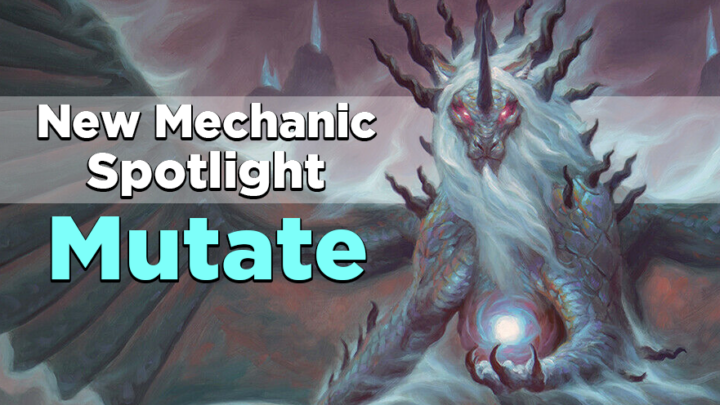As one of the most anticipated new mechanics in years, mutate has some high expectations to live up to. Wizards R&D has repeatedly tried to get a “combine your creatures” mechanic right, and after the success of host/augment in Unstable, it seemed they were getting close. The announcement of Ikoria as the “make your own monster” set, featuring “one of the craziest mechanics” certainly got the crowd fired up. And now that the new cards have mostly been spoiled, I can happily say that these are the coolest mutations since the X-Men!
MUTATE 101
Although awesome, mutate is a very new and different mechanic, so it’s worth walking through exactly what it does. Mutate is (currently) an ability found only on creatures. It’s an alternate casting cost, like Kicker. Therefore, you cannot use the mutate abilities of creatures you already have in play. When you go to cast a creature with mutate — let’s call them “mutators” — you announce whether you’re mutating or casting it normally, and pay the appropriate cost for that mode.
If you pay the mutate cost, you then target a non-human creature that’s already in play (that you own) to be mutated. Assuming the mutator resolves, you pile the mutator and target on top of each other (you choose the order) and they become one creature permanently. This new creature has the colors, name, types and power/toughness of the card you put on top of the pile, and the combined abilities of ALL creature cards in the pile — including any other mutators you add to it later!
If your beautiful mutated creature dies for any reason, all of the cards in its “pile” go to the graveyard together. It still only counts as one creature dying for triggers. If your mutated creature leaves play and then comes back (say, due to Thassa, Deep-Dwelling), then the cards in the pile come back into play as new, separate creatures. If an opponent destroys the creature you’re targeting before your mutate effect resolves, then the creature you cast in mutate mode simply enters the battlefield as itself. Never punished!
THIS MUTAIN’T IT
The reminder text for mutate is remarkably elegant, but the combination of new rules terms and a familiar-feeling effect is leading to some early misconceptions about the mechanic’s finer points. So, to quickly clarify:
- Creature cards in your mutated pile are just that in game terms: creature cards. They aren’t auras, or creatures you control, or even separate permanents attached to the top one. Mutate combines these cards so well that as long as they’re on the battlefield together, the rest of the Magic rules treat them like any other creature.
- Successfully mutating a creature in play does not make it a new creature entering the battlefield, even if you just turned a 1/1 token into a 6/6 flying trampler! Any counters it has stay on it, any auras or equipment stay attached, and delayed triggers (like having to sacrifice it after using Wings of Hubris) still happen to it. And critically, it will not be summoning sick if the original target wasn’t — allowing you to add “hasty” power to your attack by mutating something big onto something small.
- Mutate requires you to pay an alternate casting cost. You can only pay one alternate cost per spell you cast, which matters because casting free spells off Fires of Invention is also an alternate cost. Therefore, you cannot use Fires to mutate for free.
- When you use mutate, the spell you’re casting is still the original creature spell in every way. It is still a creature spell, of that name, with the CMC of the original card (not the mutate cost). You will draw a card off Beast Whisperer for it, for example.
- “Whenever this creature mutates” abilities will trigger both for the mutator and the creature it targeted. Because they occur after the creatures have combined into one, the triggers which count “the number of times this creature has mutated” will count all previous mutations of that mutator, even if the trigger came from the one you just added.
IKORIA’S MIGHTIEST MUTANTS
So, mutate has broken new ground in Magic design and won the hearts of people who care about that sort of thing (i.e. me). But no mechanic exists in a vacuum, and much of how mutate will be remembered depends on the appeal of the cards that use it. Let’s take a look at some of the standouts you’ll be seeing through Ikoria Standard and beyond.
THE FIVE (AND ONE MORE) LEGENDARY MUTATORS
This cycle of wedge-colored legends are the mythic-rare vanguard for mutate, and they definitely show the potential to make the mechanic matter in Constructed.

Snapdax, Apex of the Hunt is roughly comparable to Embercleave. You lose the combat trick potential, but Snapdax clears away a blocker and is also a serviceable four-drop on an empty board.

Nethroi, Apex of Death looks to have a Protean Hulk-like role as a finisher, reanimating an entire creature combo at once. It also offers a good defensive body that such a deck might need while you get ready to go off.
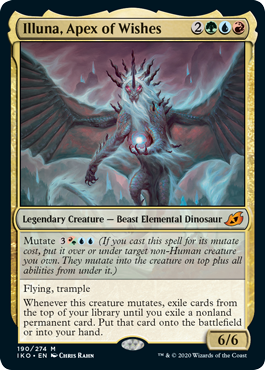
Illuna, Apex of Wishes looks to be a shot in the arm for Temur Fires, as well as some Wilderness Reclamation lists. If you flip a second Illuna, you can add it to hand and then mutate it onto the first one for a double trigger (and no legend rule!)
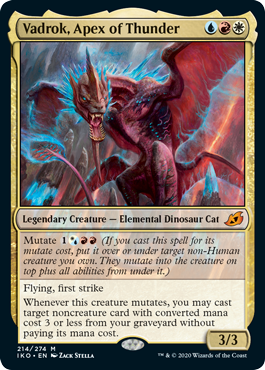
It’s harder to see exactly what to do with Vadrok, Apex of Thunder, since one of the best spells in Jeskai to recast — Deafening Clarion — will also kill Vadrok unless you mutate it under something with better stats. Still, using it to recur Teferi, Time Raveler can’t be bad.
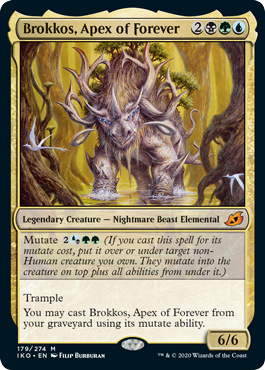
One final thing to note is that if you use any of these legends as your commander (or Otrimi, the Ever-Playful, a sixth legendary mutator printed in the upcoming Commander precons), then any mutated creature with the commander on top will deal commander damage! This should definitely be built around, using creatures with evasion, double strike, and other good damage-enhancing abilities to mutate your commander onto.
SEA-DASHER OCTOPUS, AKA OCTOPUS OBSESSION
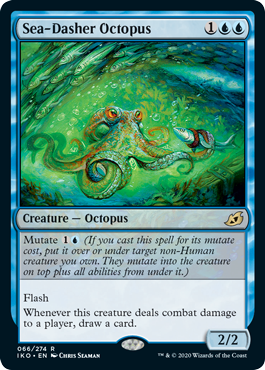
This is the best mutate card by a mile and probably a frontrunner for the best card in Ikoria, if you’re looking at potential across all Constructed formats. The hype you’ve probably heard is well justified.
Curious Obsession-based tempo decks gave us a blueprint, and we’ve had some kind of Flash deck ever since. This will almost always draw at least one card if you mutate after blocks, and will usually draw several over a few turns, often winning you the game. Put it on anything evasive or double striking, and you’re home. And of course, you can just flash the creature in as a “fail case” that’s actually fine in many scenarios.
PARCELBEAST
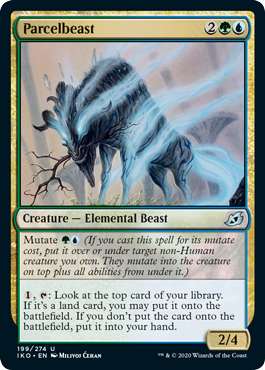
This card has a really interesting activated ability, which might lead you to miss that its mutate cost is only two mana! The tradeoff is that you don’t get a trigger for mutating like all the others, but the stats look good for a defensive creature that generates cheap advantage every turn it’s alive. Mutating this with Edgewall Innkeeper suddenly makes your card draw engine a lot more resilient!
CUBWARDEN
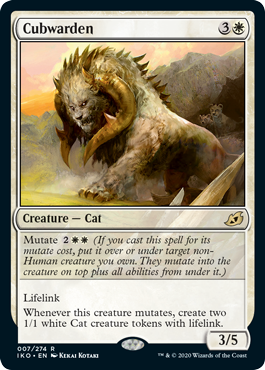
This is one of the more exciting mutate triggers for aggressive decks, but the deal you get for four mana doesn’t feel like it’s quite at a Constructed power level by itself.
You’ll want to have multiple follow-up mutators to throw down on subsequent turns to get some extra value out of Cubwarden. Snapdax is the natural curve-topper here; Huntmaster Liger is another alternative which will pump your team of tokens. Oh, and those are also both cats — something to note for Pioneer or future Standard sets, perhaps.
TRUMPETING GNARR
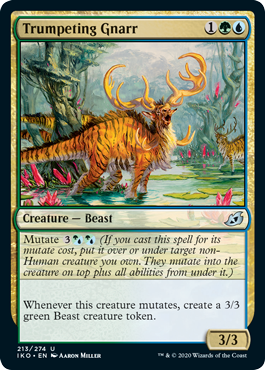
I’m not sure how it’ll go over in Constructed, but this looks like an incredible uncommon to start off Ikoria Limited decks with. Just casting Gnarr on turn three and mutating onto it on turn four will net you a nice bonus, and if you can keep your mutant alive to get a second trigger, you’ll be crowing about it.
AUSPICIOUS STARRIX
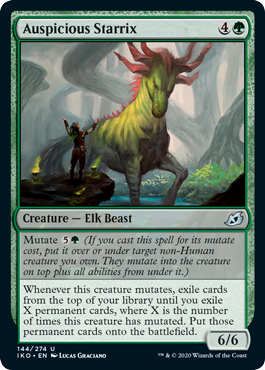
I’m not saying this card is going to break anything, but I was impressed by how few limits there are on this Genesis Wave-style trigger. There might not be many ways to cheaply “farm” mutate triggers right now, but we’ll see what’s possible down the line. I can see this doing sterling work in a mutate-focused Commander build.
STONECOIL SERPENT
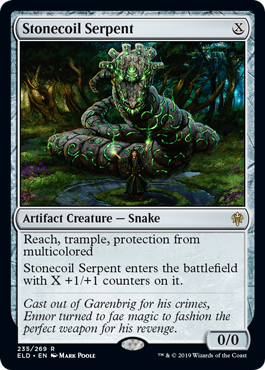
No, you’re reading this correctly — this is not an Ikoria spoiler. However, I felt obligated to include it as the 2020 yearbook winner for “most likely to be mutated.” The full value of its keywords and any counters you paid for contribute to the creature you mutate over it, making for some really terrifying threats. If you don’t have your playset ready, pick these up soon for Pioneer and Standard.
TYRANNY AND MUTATION
Mutate is a real triumph of Magic design, a robust and fun solution to a problem that Wizards had been trying to solve since Licids. While the idea of piling up cards and calculating creature stats sounds tricky, I’m sure we’ll all quickly assess the possibilities of the mechanic once we see it in action. It’s going to make Ikoria a truly unique Limited format, and there are enough standout cards to ensure mutate has some impact on Constructed and Commander as well.
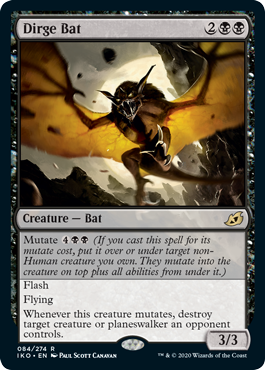
I think many of those cards are excellent (catch me playing WB cat mutants in the MTGA preview event and chortling), but the most exciting and impressive thing about mutate is the cards they haven’t made yet. Unlike bestow or meld or any of the past attempts at such a mechanic, the templating of mutate leaves plenty of room to access the effect differently. Imagine a blue instant which mutates all of a player’s creatures into one, or a Reanimate that mutates a creature from your graveyard onto one you have in play!
Yes, Ikoria will be the first showcase for mutate, but I’d be shocked if it ended up being the last. Between mutate, ability counters, and companion, there’s clearly a huge push to expand the design space of Magic through this set, and that kind of momentum tends to last. If this is the standard for new set designs over the next few years, we could soon be looking back to mutate as the beginning of Magic’s next halcyon era.

Tom’s fate was sealed in 7th grade when his friend lent him a pile of commons to play Magic. He quickly picked up Boros and Orzhov decks in Ravnica block and has remained a staunch white magician ever since. A fan of all Constructed formats, he enjoys studying the history of the tournament meta. He specializes in midrange decks, especially Death & Taxes and Martyr Proc. One day, he swears he will win an MCQ with Evershrike. Ask him how at @AWanderingBard, or watch him stream Magic at twitch.tv/TheWanderingBard.

